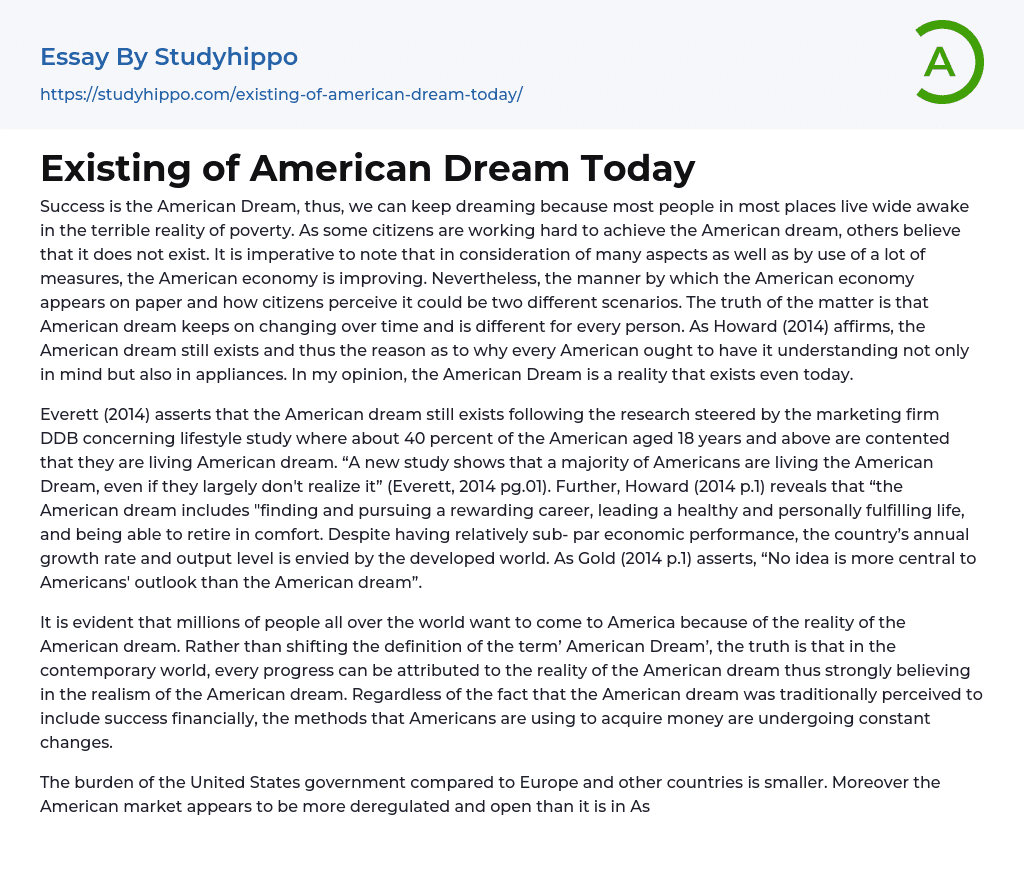Although the American Dream is perceived as a symbol of success, poverty prevents many individuals from achieving it. While some people work hard to attain this dream, others believe that it does not exist. Nevertheless, it is crucial to recognize that several factors and indicators suggest an improvement in the American economy.
Despite this, there may be a difference between the portrayal of the American economy on paper and how it is perceived by citizens. The truth is that the American dream changes over time and varies for each individual. Howard (2014) argues that the American dream still exists, highlighting why every American should understand it in their thoughts and actions. In my view, the American Dream continues to exist as a concrete concept even in present times.
According to Everett (2014), a study conducted by the marketing firm DDB revealed th
...at approximately 40 percent of American adults ages 18 and above believe they are living the American dream. However, as stated by Everett (2014, pg.01), a majority of Americans are actually living the American Dream without realizing it, as shown in the study results. Howard (2014, p.1) adds that the American dream encompasses finding and pursuing a fulfilling career, leading a healthy and satisfying life, and being able to retire comfortably. Despite economic underperformance compared to other nations, developed countries admire the country's annual growth rate and output level. Gold (2014, p.1) emphasizes that the American dream plays a central role in Americans' outlook on life, attracting millions of people from around the world to come to America.
Although the concept of the "American Dream" should not be redefined, it is important to acknowledge that all progress
in the modern world can be attributed to this dream and its belief in attainability. While traditionally associated with financial success, Americans' pursuit of wealth is constantly changing. In comparison to Europe and other nations, the burden of the United States government is smaller. Additionally, the American market offers greater opportunities for upward mobility—especially for individuals from disadvantaged backgrounds—since it is more deregulated and open than Asian, Latin American, and African markets. According to Everett (2014), the American Dream has evolved into a cultural ethos for Americans centered around individuals having control over their own lives and living according to values of freedom and human rights.
The American dream can be realized by small businesses in every town and the entrepreneurs who have generated employment opportunities and influenced oil and gas prices. If we can diminish the size and impact of the American government, there is no doubt that the power of the American Dream will increase even further in the 21st century (Kadlec 2014 p.1). Despite not being universally embraced, most individuals possess a strong comprehension of the American dream. Although numerous Americans do not hold high-paying occupations, a significant portion are self-employed, while others persistently strive for a fulfilling livelihood.
According to Everett (2014), youth unemployment is high, but both recent and early graduates have opportunities for earning income. Many Americans can afford appropriate housing, which is crucial for attaining the American Dream. However, achieving home ownership remains a struggle for numerous individuals. Those who are employed or engaged in business can earn sufficient income to sustain a comfortable lifestyle. Additionally, despite the costly nature of college education, American children continue their pursuit of higher
education.
According to a study by Everett (2014, pg.01), the majority of individuals have achieved key aspects of the American Dream such as homeownership, a good education, a stable job, and improving their children's lives. However, pursuing higher education often involves facing high costs each year. Despite this reality, critics argue that the American Dream is merely an illusory mirage.
Conclusion
The DDB research shows that around 40% of respondents are satisfied with their lives in relation to the American Dream. This indicates that the American Dream is still a reality for many Americans. These individuals believe that having control over their daily lives is an essential part of the American Dream. Despite expected increases in living expenses, Americans are determined to maintain their happiness and pursue their own version of the American Dream. It is important for the government to create strategies to address rising costs. Moreover, it is crucial to recognize that although a significant portion of the population lacks well-paying jobs, homes, secure retirement plans, access to quality healthcare, and college education; they should not be disregarded as people without dreams.
Despite the high unemployment rate, especially among young graduates, and the lasting impact of a major economic recession on the American economy, I firmly believe that unemployment is a global crisis that requires a global approach. Thus, it can be fairly stated that the American dream still exists.
References
- Everett R. (2014) American Dream Still alive, but unrecognized
- Howard R. G. (2014) Price Tag for the American dream $130 K a Year
- Kadlec D (2014), Millennials put their surprising stamp on the American Dream.




